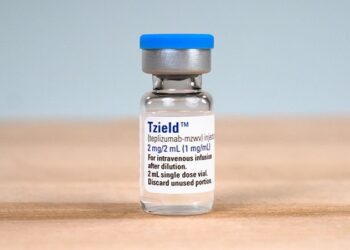Last February, Microsoft co-founder and billionaire philanthropist Bill Gates appeared on The Tonight Show and shared some bold predictions about artificial intelligence (AI). In just a decade, he told host Jimmy Fallon, AI will be capable of “great medical advice” and humans will no longer be needed “for most things.”
It’s not the first time we’ve heard claims that AI will soon replace doctors, and it’s usually hard to take seriously. But then just last month, on the heels of Gates’s tech forecast, researchers at Google published a study introducing Articulate Medical Intelligence Explorer (AMIE), an AI system designed for clinical interactions and diagnostic dialogue.

The trial “involved specialist physicians and patient actors [and] assessed diagnostic accuracy, communication, empathy, and management reasoning,” says Mike Schaekermann, PhD, a research scientist at Google Health involved in the study. “AMIE often performed comparably or better than primary care physicians in these specific research settings.” Given the provided prompts, AI achieved a correct diagnosis 60% of time compared with about 34% for unassisted human doctors.
It doesn’t mean doctors are in danger of being replaced by AI anytime soon — now, today, in 2025 — but it does beg the question: How about in 25 years? Tech years can be like dog years. Google is already partnering with Beth Israel Deaconess Medical Center on a prospective research study, “to explore how AMIE might help gather information previsit and understand clinician and patient perceptions in a real-world setting,” says Schaekermann.
As the technology continues to advance at a sprint, and researchers continue to explore AI’s applications not just as a tool but how they perform in head-to-head competitions with human physicians, is it possible that by 2050 doctors will be replaced or their roles reduced by new tech?
An AI Upheaval May (or May Not) Be Coming
Let’s play the science fiction card. Replacing doctors with machines feels like science fiction because it feels imaginary. Today. But everything from the internet to Wi-Fi to touch-screen supercomputers in our pockets felt imaginary at one time.
Science fiction-turned-facts incoming: Beckman Institute researchers recently developed an AI model that can accurately identify tumors and diseases in medical images. London’s Institute of Cancer Research has created a prototype test that uses AI to predict the best drug combinations for cancer patients in less than 48 hours. King’s College Hospital, also in London, is recruiting patients for a clinical trial of a new AI tool that can identify abnormalities on MRI head scans, and both Med-PaLM and ChatGPT have passed the US medical licensing exam.

AI is already driving significant changes in stroke diagnosis, says Luciana D’Adderio, PhD, Turing Fellow with the Alan Turing Institute and founder of the behavioural AI lab at Edinburgh University’s Centre for Medical Informatics. Her research, published last January, found that rather than using AI to confirm their diagnosis, clinicians could now use AI to make an initial assessment. “Potentially, these changes can benefit patients, improving the detection rate of large vessel occlusions,” says D’Adderio, “but perhaps more importantly by providing the clinician with immediate predictive maps of the extent of brain damage and the potential for treatment.”
And it’s only beginning. “By 2050, I expect AI to be a deeply integrated, horizontal layer across the entire diagnostic pathology workflow,” says Faisal Mahmood, PhD, associate professor of pathology at Brigham and Women’s Hospital and Harvard Medical School, whose lab is devoted to machine learning and data fusion. “Routine slides will be automatically triaged, allowing pathologists to focus on complex cases. AI will preorder ancillary tests based on predictive models, and agentic, generative AI systems will serve as intelligent assistants — answering diagnostic questions, highlighting key findings, and even drafting structured pathology reports.”
That feels like the feel-good scenario: a truly fast, accurate, dependable technology that augments the physician/patient interaction and improves care. Neither physicians nor patients would argue against such a future.

David Dranove, PhD, paints a less rosy picture. The Walter J. McNerney Professor of Health Industry Management at Northwestern University’s Kellogg School of Management has studied how AI could change the future of healthcare and suggests that by 2050, AI could “more than adequately substitute for the radiologist, and presumably at a much lower cost because AI can be scaled.”
Humans will still be needed in medicine, if only because humans are “vastly more capable of detecting and interpreting the nuances of each other’s speech, posture, facial expressions, and so forth,” he says. “These are essential to taking a medical history, forming a diagnosis, and making and communicating a treatment plan.”
What does that mean for the medical students hoping for careers in healthcare tomorrow? “You had better have strong people skills,” says Dranove. “If all you can bring to your patients is book learning — knowing what tests to order and what protocols to implement based on objective data — without the ability to make subjective decisions based on differences you perceive from one patient to another, then you might as well give way to the computer.”
Remember the term “patient care,” he advises. “If you are not good at the ‘care,’ then you may find yourself replaceable.”
It might also be useful to look at what is currently happening in nursing, with nurses unions already rising to the defense against AI encroachment in traditional nursing roles and new data already showing that AI could be far cheaper than human nurses ($9 per hour vs $35-$40 per hour for humans).
It makes sense to look at the future through the lens of basic business: If a new tech can lower costs, especially human ones, why would those cuts not be made? If a new tech can automate, streamline, and perform equally or better than a slower (human) method, why would that replacement not take place? If head-to-head doctor vs AI studies are happening now and AI is already winning, what will that competition look like in 25 years?
Still, D’Adderio isn’t convinced that an AI-inspired people-purge is coming. “Human judgement remains fundamentally important,” she says. She suspects that in another few decades, people will turn to AI tools as a first resource for their medical inquiries, “much as they already do with Google.” And AI will probably be able to retrieve multimodal data and use it to improve its predictions. But D’Adderio finds it “difficult to see AI entirely replacing clinicians, if not for the simplest tasks.”
Who (or What) Do You Trust?
In a recent Medscape interview, tech executive Peter Diamandis told the story of a close friend and colleague who felt ill and had seen several doctors over a period of months. No conclusive diagnosis was made until finally one doctor correctly diagnosed him with lymphoma.
When he got this news, his friend “took his data from 3 months earlier and fed it into Claude 3.7 for a differential diagnosis,” says Diamandis. “And lymphoma was number one on the list. From 3 months earlier. So I tell people, grab your data [and] get…not a second opinion — get an AI opinion. [T]hat’s going to become more and more common.”
That crystalizes the current debate about AI today and what AI could one day become: Do you trust your doctor? Or do you trust a machine to get it right?
Big AI trust issues remain, especially with algorithms trained on online text, which could span everything from data taken from the Centers for Disease Control and Prevention and a thread shared on X.
“Ensuring factual accuracy and mitigating misinformation are critical research priorities for medical AI,” says Schaekermann, who claims AMIE only focuses on authoritative knowledge sources, such as curated medical datasets, clinical practice guidelines, and drug formularies, “rather than learning uncontrollably from the open internet.”
But it’s not just about the misinformation creeping into AI algorithms. Before they can be deployed in hospitals and used on patients, AI vendors need to undergo stringent quality and performance validation. But once approved, “AI algorithms are ‘frozen,’ meaning that they cannot be allowed to change, or to learn from the data they process,” says D’Adderio.
What’s more, AI algorithms are tested based on databases “which may or may not represent the patient population in the hospital where they are adopted,” says D’Adderio. “For example, the software might have been tested against an east European sample population and be used in a UK hospital. This means algorithms are inherently biased and need to be retested every time they are implemented at a new hospital site to verify their performance against the hospital’s actual patient population.”
A 2024 Harvard study of GPT-3’s diagnostic and triage ability found that AI could make the correct diagnosis 88% of the time, compared with 96% among human physicians (when given the same prompts). But the tool’s accuracy was dependent on patient descriptions of their symptoms. Explanations that were poorly worded or lacked critical information — something a human doctor would be more likely to make sense of — caused AI to make more mistakes.
There’s also the question of whether patients will want to share medical information with a chatbot rather than a flesh-and-blood person. A 2023 Pew survey found that 60% of Americans “would feel uncomfortable if their own health care provider relied on artificial intelligence to do things like diagnose disease and recommend treatments.”
That same year, the mental health app Koko experimented with GPT-3 to compose encouraging messages for their 4000 users. But according to Koko cofounder Rob Morris, who shared his thoughts on X, although the tech did allow them to interact more quickly and efficiently, users weren’t impressed.
The “simulated empathy feels weird, empty,” Morris wrote. “Machines don’t have lived, human experience, so when they say ‘that sounds hard’ or ‘I understand,’ it sounds inauthentic.”
Humans and AI, Better Together
Some researchers warn that replacing physicians with AI runs the risk of “Turing trap thinking,” says Nigam Shah, MBBS, PhD, professor of medicine at Stanford University and chief data scientist for Stanford Health Care. The Turing test, first proposed by computer scientist Alan Turing in 1950, suggested that if a machine can provide an answer that makes it indistinguishable from a human, then and only then can it be described as “intelligent.”

In 2023, Shah and his colleagues took a closer look at this theory in a medical setting, studying whether 430 volunteers could tell the difference between ChatGPT and a flesh-and-blood doctor. On average, patients correctly identified both the real doctor and their AI equivalent just 65% of the time. And they were less likely to trust a chatbot’s diagnosis for high-risk or complex questions.
Rather than trying to outperform or replace humans, Shah says, the focus should be on how AI can complement human work. “Today’s thinking seems to imagine the human as either an overwatch — to catch AI’s error — or an impediment to full value of AI,” he says. “We need to ask the question: What are optimal human-AI teaming set-ups? Maybe AI does the screening to reduce human labor.”
The ideal integration of AI into medical diagnostics might involve finding how these two very unique kinds of expertise — the machine’s ability to rapidly detect emergent patterns drawing on vast amounts of data, and human clinical judgement — can work together seamlessly. Even in another 25 years, “humans will remain fundamental for complex diagnoses,” D’Adderio says. “AI is not infallible; we still require clinicians to retrospectively verify the accuracy of its determinations.”
Mahmood’s recent research on AI models for pathology, such as UNI and CONCH, has demonstrated how the technology can enhance diagnostic accuracy by leveraging large-scale datasets. His hope is that this will eventually allow for “a more holistic and scalable approach to rare disease diagnosis,” he says.
But Schaekermann points out that even as AI becomes more sophisticated, with deeper reasoning and multimodality, “we envision the technology primarily enhancing, not replacing, clinicians,” he says. “Especially for complex interactions like checkups that rely heavily on human judgment, empathy, and the provider-patient relationship. The goal is for AI to handle specific tasks, freeing clinicians to focus on the human aspects of care.”
Shah recommends that any medical student hoping for a lasting career should do more than just familiarize themselves with data science and mathematics. It needs to become an academic priority. “Many high school students are already developing good data sense,” he says. “Which will position them very well to operate in the technology-heavy medical world of the future.”
Jesse Ehrenfeld, MD, former president of the American Medical Association, puts it more succinctly: “ AI is not going to replace doctors,” he says, “but doctors using AI will replace doctors who aren’t using AI.”
Source link : https://www.medscape.com/viewarticle/ai-vs-physicians-2050-happy-future-or-no-future-2025a1000cv2?src=rss
Author :
Publish date : 2025-05-21 18:51:00
Copyright for syndicated content belongs to the linked Source.














